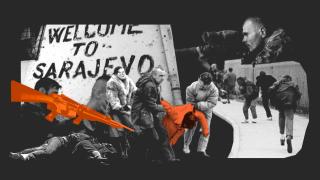It is one of the darkest episodes of the Bosnian genocide. An episode buried for decades that now floats on the surface of consciences in Italy. But not only in Italy. The wall of silence finally collapsed at the beginning of this week, when the Milan Prosecutor’s Office opened a criminal investigation into the so-called ‘human safaris’ to Sarajevo besieged by Bosnian Serb troops in the early 1990s.
These ‘human safaris’ were nothing more than leisure trips undertaken by at least 200 Italian citizens during the 47 months that the siege of the city lasted. A brutal siege that caused the death of 11,000 people between 1993 and 1995. Among the victims were 1,601 minors.
Tourists paid large sums of money to these macabre travel agencies – around 90,000 euros, according to the first hypotheses of the investigation – to play war during the weekends. Killing children was more expensive, but shooting women and the elderly could be free.
Italian tourists traveled dressed in camouflage clothing from the regions of Triveneto, Piedmont or Lombardy. They flew from Trieste to Belgrade, using the infrastructure of the former Serbian charter and tourism airline Aviogenex.
They crossed checkpoints in minibuses, paying bribes with the excuse of attending humanitarian missions. Once in Sarajevo, they were stationed alongside the Bosnian Serb troops on the hills that encapsulate the city to shoot from above against the defenseless civilian population.
They were people who paid to receive permission to hurt or directly kill other people. They were hunters of human beings. After “living the experience,” they returned home, as if nothing had happened.
A documentary, a complaint
Justice will arrive more than thirty years late – although only for those guilty of Italian nationality – and even though the SISMI, the defunct transalpine military secret service, would have been aware of these events since the beginning of 1994, according to various testimonies.
The Milan Prosecutor’s Office began working on this matter following the complaint filed on January 28 by the journalist and writer Ezio Gavazzeniwhich had the legal assistance of the lawyer Nicola Brigida and the former magistrate Guido Salvinispecialized in the fight against terrorism.
The prosecutor Alessandro Gobbiswhich is investigating the case, is now working to find the identity of these 200 “war tourists” whom it intends to accuse of the crime of voluntary manslaughter aggravated by cruelty and abject motives.
“There were wealthy businessmen and professionals, from northern Italy, but also from Spain, France and other European countries, as well as from Canada and the United States who paid to go to the mountains surrounding Sarajevo to shoot people,” Gavazzeni underlines in statements reported by the newspaper. Il Sole 24 Ore.
The 17-page complaint, which includes a report by the former mayor of Sarajevo, Benjamina Karićdoes not include their identities – it only mentions three men: one from Turin, one from Trieste and one from Milan, owner of a private cosmetic surgery clinic – but the writer suspects that they were people “who knew, in any case, very well the use of weapons and rifles. People who today are between 65 and 80 years old.”
Gavazzeni draws more precisely the profile of the suspect: owner of a large fortune, fan of traditional safaris, in search of adrenaline and “human” trophies, lover of weapons with psychopathic or sadistic traits.
“Although it is comforting to see that the Italian authorities are finally acting on this information, we have known for a long time that this barbaric ‘war tourism’ was occurring,” he points out in conversation with this newspaper. Georgio ConstantiBosnian genocide researcher and founder of Drina Voices, the first educational tool on the massacre.
Konstandi credits members of the Bosnian community such as Haris Imamovićwho addressed this topic in his novel Vedran and the Fireman (Sandorf, 2022). “In addition to Imamović’s book, the Slovenian director Miran Zupanić premiered his documentary Sarajevo Safari at the end of the same year at the Al Jazeera Balkans Documentary Film Festival,” recalls the researcher.
Zupanić himself says that he learned about this story through the film producer Franci Zajc back in 2019. He spent the next four years working on the documentary. “When he told me about the safari, my reaction was that something like that was impossible. That hunting people was a story, an urban legend,” the filmmaker declared three years ago in an interview with the newspaper Balkan Insight.
“What took us the most time was looking for witnesses,” Zupanić admitted at the time. “Franci [Zajc] took care of that, and so we reached another intelligence officer who was then working in the analytical service of the Army of Bosnia and Herzegovina and was investigating a case that confirmed the appearance of those hunters on the Sarajevo battlefield.” That is the main source of the documentary.
Imamović, who advised the former Bosnian member of the tripartite Presidency of Bosnia and Herzegovina, Sefik Dzaferovicshares with EL ESPAÑOL another decisive testimony in this story: the one given by the former US marine John Jordan before the International Criminal Tribunal for the former Yugoslavia during the trial of the commander of the Bosnian Serb army Ratko Mladicheld in 2007.
“I have seen on more than one occasion people who did not look like they were local because of their clothing, because of the weapons they carried, because of the way they were treated, guided by the locals,” said Jordan, a firefighter who worked as a volunteer in besieged Sarajevo. “It was evident that the person guided by men who knew the terrain well was completely alien to it, and their way of dressing and the weapons they carried made me think they were tourist shooters.”
“When a guy appears with a weapon that seems more suitable for hunting wild boars in the Black Forest than for urban combat in the Balkans… when you see him handle it, you understand that he is a novice,” he said eighteen years ago.

